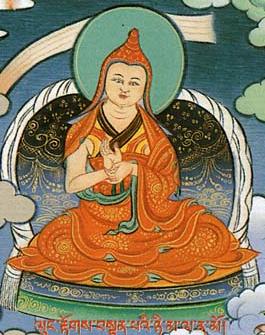Nyoshul Lungtok Tenpé Nyima

Nyoshul Lungtok Tenpé Nyima (Wyl. smyo shul lung rtogs bstan pa'i nyi ma) (1829-1901/2) received the Dzogchen teachings from Patrul Rinpoche and was his greatest disciple.
Biography
Lungtok Tenpé Nyima was born into the Nyoshul family of the Mukpo Dong family within the kingdom of Dergé. From an early age he demonstrated all the signs of a bodhisattva and was proclaimed an emanation of Avalokiteshvara. He studied at Dzogchen Monastery with Gyalsé Shenpen Thayé from whom he received monastic ordination and the name Lungtok Tenpé Nyima.
His main teacher was Patrul Rinpoche whom he followed for twenty-eight years.[1] During this time he acted as his attendant and heard every teaching he gave. According to Nyoshul Khenpo this meant that Lungtok, together with Khenpo Kunzang Sonam, received teachings on the Bodhicharyavatara no less than eighty times.[2] The way Patrul Rinpoche introduced him to the nature of mind has been recounted many times. Sogyal Rinpoche writes:
- They were almost inseparable, so great was the love and devotion between them. Patrul Rinpoche, who was from the Dzachukha region of Kham in East Tibet, always used to call him ‘a-mi’, an affectionate way of saying ‘my son’. Nyoshul Lungtok would keep telling Patrul Rinpoche that he had not yet got the main point, of realizing the Rigpa. Maybe he had, but he really wanted to be sure, so he kept on asking him. Then Patrul Rinpoche gave him the introduction. It happened one evening, whilst Patrul Rinpoche was staying up in one of the retreat centres above Dzogchen monastery. It was a very beautiful night; the sky was clear, and the stars were very bright. It was very quiet, and the sound of solitude was heightened by the distant barking of a dog from the monastery down below.
- Nyoshul Lungtok had not asked him anything that evening, and Patrul Rinpoche called him over, saying: “Didn’t you tell me that you still hadn’t got the main point of the practice of Dzogchen?” Nyoshul Lungtok replied: “Yes, that’s right”.
- “It’s very simple”, he said, and lying down on the ground, he beckoned to him: “My son, come and lie down here like your father”. So Nyoshul Lungtok did so. Then Patrul Rinpoche asked him, in a very affectionate way: “Do you see the stars in the sky?”
- “Yes”.
- “Do you hear the dogs barking from the Dzogchen monastery?”
- “Yes.”
- “Do you hear what I am saying to you?”
- “Yes.”
- “Well, the nature of Dzogpachenpo is just—simply this.”
- At this moment, everything fell into place, and instantaneously Nyoshul Lungtok was completely realized.[3]
After serving his teacher and spending many years in retreat, Lungtok was finally told by Patrul Rinpoche to return to his homeland in Nyoshul Valley and live in a hermitage there. Patrul Rinpoche also predicted that he would meet an emanation of Vimalamitra, i.e., the great Khenpo Ngawang Palzang.
Lungtok also studied with Jamyang Khyentse Wangpo, receiving from him the Nyingtik Yabshyi and other transmissions. It was while he was at Dzongsar that he offered teachings on Yeshe Lama to a group of masters that included Loter Wangpo and Mipham Rinpoche.
Later he spent nine years at the Dharma encampment of Nyala Pema Düddul, teaching the tertön's foremost disciples, including Nyala Rangrik Dorje, and thousands of others.
In his sixtieth year, in accordance with the wishes of his guru, he returned to his homeland and settled in an encampment on the peak of Mount Pema Rito in the region of Trom. It was there that he taught the young Khenpo Ngakchung and many other fortunate disciples.
He passed away at the age of seventy-two on the seventeenth day of the fifth lunar month.[4]
Students
Amongst his great disciples were Tertön Sogyal, Khenpo Ngawang Palzang (1879-1941), and Loter Wangpo.
Incarnations
He prophesied that he would have thirteen incarnations named Nyima. The one who took up residence at his own former seat was Shedrup Tenpé Nyima.
Writings
His writings include a set of secret Dzogchen instructions offered to Lama Rangrik Dorje. They were sent to Rangrik Dorje with the instruction that he burn them immediately after reading them, which he did. Still, the text has survived because a copy was made by the messenger charged with delivering it.
Notes
- ↑ Dzogchen and Padmasambhava says eighteen years, but this appears to be incorrect.
- ↑ Marvelous Garland, p. 240.
- ↑ Dzogchen & Padmasambhava
- ↑ There is some confusion over his dates. Tulku Thondup (p.225) says that he passed away on the twenty-fifth day of the fifth month, whereas Nyoshul Khenpo says it was the seventeenth. On p. 225 Tulku Thondup even gives the year of his death as 1925, which is clearly a mistake. On p.222 he gives the usual year of 1901/2. The recently published snga 'gyur rdzogs chen chos byung chen mo (p.589) says he passed away on the seventeenth day of the fifth month of the Iron Ox year which would be 1901. In the notes to his translation of Nyoshul Khen Rinpoche's Marvelous Garland of Rare Gems (n. 41, p.645), Lama Chökyi Nyima states that it was the Iron Rat year, i.e., 1900, but he does not specify his source.
Further Reading
In Tibetan
The principal Tibetan source of information on Nyoshul Lungtok's life is the autobiography of his foremost disciple Khenpo Ngawang Palzang.
In English
- Nyoshul Khenpo, A Marvelous Garland of Rare Gems: Biographies of Masters of Awareness in the Dzogchen Lineage, Padma Publications, 2005, pp. 239-246
- Tulku Thondup, Masters of Meditation and Miracles, edited by Harold Talbott, Boston: Shambhala, 1996, pp.222-225